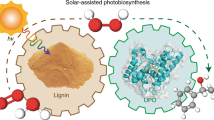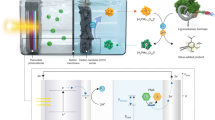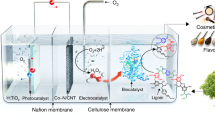Abstract
Lignocellulose is Earth’s most abundant form of biomass and its valorization to H2 is a key objective for the generation of renewable fuels. Solar-driven photocatalytic reforming of lignocellulose to H2 at ambient temperature offers a sustainable route towards this goal, but this reaction is currently limited to noble-metal-containing systems that operate with low activity under ultraviolet light. Here, we report the light-driven photoreforming of cellulose, hemicellulose and lignin to H2 using semiconducting cadmium sulfide quantum dots in alkaline aqueous solution. We show that basic conditions cause these dots to become coated with oxide/hydroxide in situ, presenting a strategy to improve their photocatalytic performance. The system operates under visible light, is stable beyond six days and is even able to reform unprocessed lignocellulose, such as wood and paper, under solar irradiation at room temperature, presenting an inexpensive route to drive aqueous proton reduction to H2 through waste biomass oxidation.
This is a preview of subscription content, access via your institution
Access options
Access Nature and 54 other Nature Portfolio journals
Get Nature+, our best-value online-access subscription
$29.99 / 30 days
cancel any time
Subscribe to this journal
Receive 12 digital issues and online access to articles
$119.00 per year
only $9.92 per issue
Buy this article
- Purchase on Springer Link
- Instant access to full article PDF
Prices may be subject to local taxes which are calculated during checkout




Similar content being viewed by others
References
US Energy Information Administration Short-Term Energy and Summer Fuels Outlook (US Department of Energy, 2016).
Tertzakian, P. A Thousand Barrels a Second: The Coming Oil Break Point and the Challenges Facing an Energy Dependent World (McGraw-Hill Education, 2006).
Murray, J. & King, D. Oil’s tipping point has passed. Nature 481, 433–435 (2012).
IPCC Climate Change 2013: The Physical Science Basis (eds Stocker, T. F. et al.) (Cambridge Univ. Press, 2013).
Tracking Clean Energy Progress 2015—Energy Technology Perspectives 2015 Excerpt IEA Input to the Clean Energy Ministerial (International Energy Agency, 2015).
Moret, S., Dyson, P. J. & Laurenczy, G. Direct synthesis of formic acid from carbon dioxide by hydrogenation in acidic media. Nat. Commun. 5, 4017 (2014).
Iulianelli, A., Liguori, S., Wilcox, J. & Basile, A. Advances on methane steam reforming to produce hydrogen through membrane reactors technology: a review. Catal. Rev. 58, 1–35 (2016).
US Department of Energy Multi-Year Research, Development, and Demonstration Plan—3.1 Hydrogen Production (Office of Energy Efficiency Renewable Energy, 2015).
Rubin, E. M. Genomics of cellulosic biofuels. Nature 454, 841–845 (2008).
Huber, G. W., Iborra, S. & Corma, A. Synthesis of transportation fuels from biomass: chemistry, catalysts, and engineering. Chem. Rev. 106, 4044–4098 (2006).
Zinoviev, S. et al. Next-generation biofuels: survey of emerging technologies and sustainability issues. ChemSusChem 3, 1106–1133 (2010).
Puga, A. V. Photocatalytic production of hydrogen from biomass-derived feedstocks. Coord. Chem. Rev. 315, 1–66 (2016).
Shimura, K. & Yoshida, H. Heterogeneous photocatalytic hydrogen production from water and biomass derivatives. Energy Environ. Sci. 4, 2467–2481 (2011).
Xia, Q. et al. Direct hydrodeoxygenation of raw woody biomass into liquid alkanes. Nat. Commun. 7, 11162 (2016).
Li, C., Zheng, M., Wang, A. & Zhang, T. One-pot catalytic hydrocracking of raw woody biomass into chemicals over supported carbide catalysts: simultaneous conversion of cellulose, hemicellulose and lignin. Energy Environ. Sci. 5, 6383–6390 (2012).
Himmel, M. E. et al. Biomass recalcitrance: engineering plants and enzymes for biofuels production. Science 315, 804–807 (2007).
Sun, Y. & Cheng, J. Hydrolysis of lignocellulosic materials for ethanol production: a review. Bioresour. Technol. 83, 1–11 (2002).
Zhang, G. et al. Simultaneous cellulose conversion and hydrogen production assisted by cellulose decomposition under UV-light photocatalysis. Chem. Commun. 52, 1673–1676 (2016).
Kawai, T. & Sakata, T. Conversion of carbohydrate into hydrogen fuel by a photocatalytic process. Nature 286, 474–476 (1980).
Speltini, A. et al. Sunlight-promoted photocatalytic hydrogen gas evolution from water-suspended cellulose: a systematic study. Photochem. Photobiol. Sci. 13, 1410–1419 (2014).
Xu, Y. & Schoonen, M. A. A. The absolute energy positions of conduction and valence bands of selected semiconducting minerals. Am. Mineral. 85, 543–556 (2000).
Cao, S., Chen, Y., Wang, C.-J., Lv, X.-J. & Fu, W.-F. Spectacular photocatalytic hydrogen evolution using metal-phosphide/CdS hybrid catalysts under sunlight irradiation. Chem. Commun. 51, 8708–8711 (2015).
Xu, Y., Huang, Y. & Zhang, B. Rational design of semiconductor-based photocatalysts for advanced photocatalytic hydrogen production: the case of cadmium chalcogenides. Inorg. Chem. Front. 3, 591–615 (2016).
Budtova, T. & Navard, P. Cellulose in NaOH-water based solvents: a review. Cellulose 23, 5–55 (2016).
Chang, C. M., Orchard, K. L., Martindale, B. C. M. & Reisner, E. Ligand removal from CdS quantum dots for enhanced photocatalytic H2 generation in pH neutral water. J. Mater. Chem. A 4, 2856–2862 (2016).
Spanhel, L., Haase, M., Weller, H. & Henglein, A. Photochemistry of colloidal semiconductors. 20. Surface modification and stability of strong luminescing CdS particles. J. Am. Chem. Soc. 109, 5649–5655 (1987).
Moulder, J. F., Stickle, W. F., Sobol, P. E. & Bomben, K. D. Handbook of X-ray Photoelectron Spectroscopy: A Reference Book of Standard Spectra for Identification and Interpretation of XPS Data (Physical Electronics, 1995).
Hammond, J. S., Gaarenstroom, S. W. & Winograd, N. X-ray photoelectron spectroscopic studies of cadmium- and silver-oxygen surfaces. Anal. Chem. 47, 2193–2199 (1975).
Schreder, B. et al. Raman spectroscopy of II–VI semiconductor nanostructures: CdS quantum dots. J. Raman Spectrosc. 34, 100–103 (2003).
Kumar, S., Ojha, A. K. & Singh, R. K. Synthesis and Raman signature for the formation of CdO/MnO2 (core/shell) nanostructures. J. Raman Spectrosc. 45, 717–722 (2014).
Cuscó, R. et al. Raman scattering of cadmium oxide epilayers grown by metal-organic vapor phase epitaxy. J. Appl. Phys. 107, 063519 (2010).
Williams, R. & Labib, M. E. Zinc sulfide surface chemistry: an electrokinetic study. J. Colloid Interface Sci. 106, 251–254 (1985).
Kuehnel, M. F., Wakerley, D. W., Orchard, K. L. & Reisner, E. Photocatalytic formic acid conversion on CdS nanocrystals with controllable selectivity for H2 or CO. Angew. Chem. Int. Ed. 54, 9627–9631 (2015).
Dworak, L. et al. Ultrafast charge separation at the CdSe/CdS Core/Shell quantum dot/methylviologen interface: implications for nanocrystal solar cells. J. Phys. Chem. C 115, 3949–3955 (2011).
Simon, T. et al. Redox shuttle mechanism enhances photocatalytic H2 generation on Ni-decorated CdS nanorods. Nat. Mater. 13, 1013–1018 (2014).
Speltini, A. et al. Swine sewage as sacrificial biomass for photocatalytic hydrogen gas production: explorative study. Int. J. Hydrogen Energy 39, 11433–11440 (2014).
Cai, J. & Zhang, L. Rapid dissolution of cellulose in LiOH/Urea and NaOH/Urea aqueous solutions. Macromol. Biosci. 5, 539–548 (2005).
Ramos, M. L., Caldeira, M. M. & Gil, V. M. S. NMR spectroscopy study of the complexation of D-gluconic acid with tungsten(VI) and molybdenum(VI). Carbohydr. Res. 304, 97–109 (1997).
Wölfel, R., Taccardi, N., Bösmann, A. & Wasserscheid, P. Selective catalytic conversion of biobased carbohydrates to formic acid using molecular oxygen. Green Chem. 13, 2759–2763 (2011).
Fischer, S., Leipner, H., Thümmler, K., Brendler, E. & Peters, J. Inorganic molten salts as solvents for cellulose. Cellulose 10, 227–236 (2003).
Zhao, J., Holmes, M. A. & Osterloh, F. E. Quantum confinement controls photocatalysis: a free energy analysis for photocatalytic proton reduction at CdSe nanocrystals. ACS Nano 7, 4316–4325 (2013).
Yang, J., Liu, H., Martens, W. N. & Frost, R. L. Synthesis and characterization of cobalt hydroxide, cobalt oxyhydroxide, and cobalt oxide nanodiscs. J. Phys. Chem. C 114, 111–119 (2010).
Wu, K. et al. Hole removal rate limits photodriven H2 generation efficiency in CdS-Pt and CdSe/CdS-Pt semiconductor nanorod–metal tip heterostructures. J. Am. Chem. Soc. 136, 7708–7716 (2014).
Kadam, S. R. et al. A green process for efficient lignin (biomass) degradation and hydrogen production via water splitting using nanostructured C, N, S-doped ZnO under solar light. Roy. Soc. Chem. Adv. 4, 60626–60635 (2014).
Li, C., Zhao, X., Wang, A., Huber, G. W. & Zhang, T. Catalytic transformation of lignin for the production of chemicals and fuels. Chem. Rev. 115, 11559–11624 (2015).
Müller, U., Rätzsch, M., Schwanninger, M., Steiner, M. & Zöbl, H. Yellowing and IR-changes of spruce wood as result of UV-irradiation. J. Photochem. Photobiol. B 69, 97–105 (2003).
Kumar, P., Barrett, D. M., Delwiche, M. J. & Stroeve, P. Methods for pretreatment of lignocellulosic biomass for efficient hydrolysis and biofuel production. Ind. Eng. Chem. Res. 48, 3713–3729 (2009).
Fang, X., Mark, G. & von Sonntag, C. OH radical formation by ultrasound in aqueous solutions Part I: the chemistry underlying the terephthalate dosimeter. Ultrason. Sonochem. 3, 57–63 (1996).
Goldstein, S., Aschengrau, D., Diamant, Y. & Rabani, J. Photolysis of aqueous H2O2: quantum yield and applications for polychromatic UV actinometry in photoreactors. Environ. Sci. Technol. 41, 7486–7490 (2007).
Awatani, T., Dobson, K. D., McQuillan, A. J., Ohtani, B. & Uosaki, K. In situ infrared spectroscopic studies of adsorption of lactic acid and related compounds on the TiO2 and CdS semiconductor photocatalyst surfaces from aqueous solutions. Chem. Lett. 27, 849–850 (1998).
Huang, L. et al. Dual cocatalysts loaded type I CdS/ZnS core/shell nanocrystals as effective and stable photocatalysts for H2 evolution. J. Phys. Chem. C 117, 11584–11591 (2013).
Yu, W. W., Qu, L., Guo, W. & Peng, X. Experimental determination of the extinction coefficient of CdTe, CdSe, and CdS nanocrystals. Chem. Mater. 15, 2854–2860 (2003).
Suzuki, K. et al. Reevaluation of absolute luminescence quantum yields of standard solutions using a spectrometer with an integrating sphere and a back-thinned CCD detector. Phys. Chem. Chem. Phys. 11, 9850–9860 (2009).
Reisner, E. et al. Research data supporting “Solar-driven reforming of lignocellulose to H2 with a CdS/CdOx photocatalyst”. Apollo https://doi.org/10.17863/CAM.7480 (2017).
Acknowledgements
This work was supported by the Christian Doppler Research Association (Austrian Federal Ministry of Science, Research and Economy and the National Foundation for Research, Technology and Development), the OMV Group (to E.R.), the EPSRC (DTA studentships for D.W.W. and T.E.R), the Isaac Newton Trust, the German Research Foundation (to M.F.K.), the World Premier Institute Research Center Initiative (WPI), MEXT, Japan (to K.L.O.) and a Marie Curie Research fellowship (to K.H.L., GAN 701192 - VSHER). We would like to thank Mr Adam Brown (Cambridge, UK) for performing XPS measurements, Prof. Peter Hildebrandt (TU Berlin, Germany) for providing access to his laboratory to record Raman spectra and Dr Benjamin Martindale for proofreading this manuscript.
Author information
Authors and Affiliations
Contributions
D.W.W., M.F.K. and E.R. conceived the research. D.W.W. and M.F.K. performed photocatalysis and NMR experiments. D.W.W. and K.L.O. synthesized and characterized the QDs. K.L.O. executed TEM, XRD and the zeta potential analysis. K.H.L. carried out the Raman experiments. D.W.W. and T.E.R. carried out the fluorescence measurements. All authors analysed the data. D.W.W. wrote the manuscript. M.F.K., K.H.L. and E.R. added to the discussion and contributed to the preparation of the manuscript. E.R. supervised the work.
Corresponding author
Ethics declarations
Competing interests
Patent applications covering this work have been filed by Cambridge Enterprise (UK patent application numbers GB1619953.1 and GB1701130.5) that name D.W.W., M.F.K., K.L.O. and E.R. as inventors.
Supplementary information
Supplementary Information
Supplementary Tables 1–10, Supplementary Figures 1–14. (PDF 1688 kb)
Supplementary Video 1
Video of the reported system evolving H2 in the presence of a cutting from a wooden branch or paper. 3.6 nmol of ligand-free CdS QDs in DMF are injected onto each substrate and dried. The substrate was then added to 2 ml of 10 M KOH, forming CdS/CdOx. Samples were purged with N2 and irradiated using simulated solar light (AM 1.5G, 100 mW cm−2) for 1 h before filming. Filming was undertaken while irradiating with light from a nearby Kodak carousel 2020 projector. (MP4 116522 kb)
Rights and permissions
About this article
Cite this article
Wakerley, D., Kuehnel, M., Orchard, K. et al. Solar-driven reforming of lignocellulose to H2 with a CdS/CdOx photocatalyst. Nat Energy 2, 17021 (2017). https://doi.org/10.1038/nenergy.2017.21
Received:
Accepted:
Published:
DOI: https://doi.org/10.1038/nenergy.2017.21
This article is cited by
-
Solar reforming as an emerging technology for circular chemical industries
Nature Reviews Chemistry (2024)
-
Photocatalysts for steering charge transfer and radical reactions in biorefineries
Nature Synthesis (2024)
-
Cellulose fibers/polydopamine/zinc sulfide composite paper: predoping in situ fabrication for biphase interface photocatalytic hydrogen production from water
Cellulose (2024)
-
Recent global insight into mitigation of plastic pollutants, sustainable biodegradable alternatives, and recycling strategies
International Journal of Environmental Science and Technology (2023)
-
A Systematic Review on Photocatalytic Biohydrogen Production from Waste Biomass
BioEnergy Research (2023)



